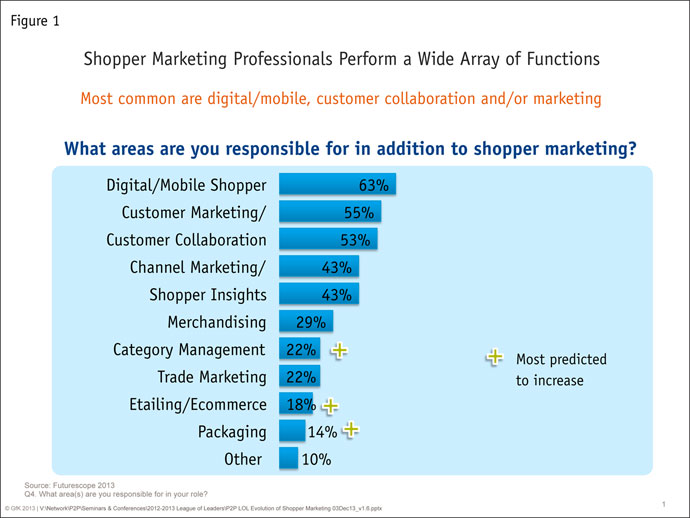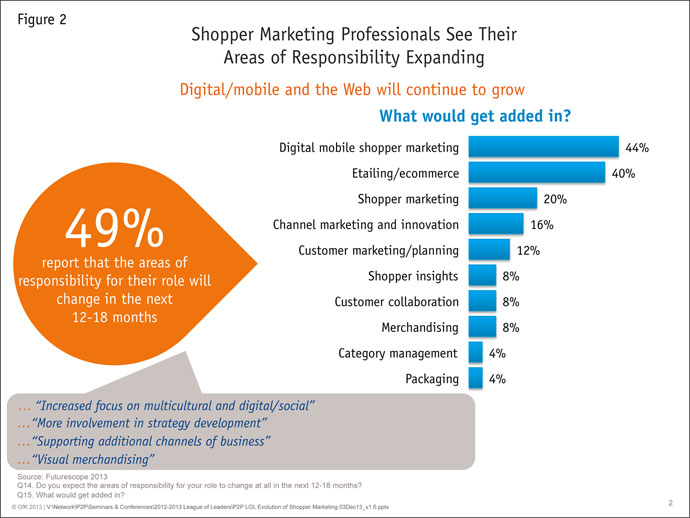Editor's note: Sarah Gleason is senior vice president in shopper and retail strategy at GfK.
Shopper marketing (SM) has come a long way. Just a few years ago, it was a little-understood task driven by promotions or channel marketing and focused primarily on trade. Today, 77 percent of CPG companies and retailers have a dedicated shopper marketing function and there is an increasing view that shopper insights are strategically essential.
But technology continues to transform the shopping experience and consumer expectations. GfK research shows that over one-third of U.S. shoppers now use both online and offline sources of information when making purchase decisions. And the proliferation of online researching and shopping – via a variety of devices – has created a host of big-data information streams that can drive new insights on shopper behaviors. This richness presents big opportunities and equally big challenges to shopper pros.
So where will shopper marketing be in 2020? Having come so far so quickly, what frontiers will it conquer next? Might it even disappear completely, absorbed into new, digitally-focused brand and data management roles?
GfK recently spoke to over 50 shopper marketing professionals in 40 companies, revisiting an important series of issues first measured in FutureScope 2006. (Executed annually since 2006, the GfK FutureScope benchmarking study gathers perspectives from shopper marketing professionals in a broad range of categories, from food/beverage to consumer electronics.) The new data show that shopper marketing is now taken more seriously, has a broader purview and plays a bigger role in marketing and retailer account planning decisions. But its future is contingent on a still-evolving set of company and category needs, analytical skills, and digital data sources.
More strategic than tactical?
An important change has been the emerging perception that shopper marketing is more strategic than tactical, driven by investment in robust and revealing shopper insights. One in five shopper marketers now says that his or her organization views SM as “highly strategic” – an impressive proportion for a function once viewed as almost purely tactical. Senior management is now more likely to see insight-driven shopper marketing as a necessity for guiding successful brands, rather than a “bolt-on” with narrow applications.
The shopper professional’s ability to synthesize and imbed insights that drive business at retail has been key to this shift. Becoming valued but humble team members, shopper marketers have learned to add their particular brand of consumer intelligence to the decision mix, particularly as it relates to shopping behavior (Figure 1). They have become better collaborators, earning the support of senior management and being viewed as a lever to accelerate revenue and strengthen crucial retailer relationships.

In addition, shopper marketers are valued for decision-making because they understand and encourage the links between brand marketing and sales, specifically the retailer’s objectives. Shopper marketers live partly in the global brand world and partly at the local level – where in-store activities play out and help determine the fates of products, categories and stores. Shopper pros can mediate between the goals of brands and chains, bringing retailer considerations into decision discussions early on, while staying focused on big ideas that can impact shopper behavior at a national (or even global) level.
Shopper marketers also often partner with other departments in bringing marketing initiatives to the mobile devices that are upscale consumers’ favorite researching and shopping tools. The very nature of the SM role means shopper pros need to stay up to speed on how shoppers are using these devices and the best ways to leverage them to impact shopper behavior – without becoming an intrusive presence.
Grow their role
So where are all these very positive trends leading? What will savvy shopper marketers need to know in 2020 and how will they continue to grow their role in the marketing organization?
First, as the shopping process becomes more complex, we see the need for dedicated shopper marketing and insights resources growing – not being absorbed into other functions, Whether on Web shopping sites or in brick-and-mortar stores, the shopper’s experience and wishes will remain essential to understand, for brands and retailers alike. In addition, the need to bridge the gap between corporate priorities and field-level retailer needs will continue.
If anything, stores will become more locally oriented to leverage their special advantage as a neighbor and in-person advisor – a valuable differentiator from anonymous online shopping sites. At the same time, retailers must offer a seamless experience for shoppers between on and offline, so as to complete the conversion of a sale. Brands will also need to key into these movements, supporting them through a variety of efforts and also advancing their own sales agenda in the process. Shopper marketers will bring on-the-ground expertise to make all of this happen.
Fully half (49 percent) of shopper marketers in the FutureScope survey said they expect their roles to change in the coming 12 to 18 months (Figure 2). What will be added? Not surprisingly, digital/mobile shopper marketing (44 percent) and e-tailing/e-commerce (40 percent) top the list, trailed distantly by answers like “channel marketing and innovation” (16 percent) and even packaging (4 percent).

A recurring theme in our look at the future of shopper marketing is “turning insights into activation.” At one level, this means pure data integration; there has been a massive investment in insights along the path to purchase but the information is often siloed and rarely brought together with any sophistication. All key constituents know big data is everywhere but they need help tapping into the streams and making them answer relevant, decision-changing questions. Shopper marketers hold the key.
When asked who is responsible for turning insights to actions in their companies at the total business level, 63 percent of shopper marketers said that role falls to them. At the brand level, still more than half (53 percent) saw themselves as tops – more than double the percentage for any other job role. We see this immersion in data activation – and into in-market strategies and solutions – only growing and even expanding to related areas.
Making this activation happen requires not just data expertise but the shopper professional’s newly honed collaborative skill. As one shopper marketer said to us, “Internal in-fighting between consumer and shopper researchers needs to stop so we can get better at data integration.” In the coming years, shopper marketers will find themselves called on more and more to act not just as team members but as conductors of the shopper and retailer insights “orchestra,” as hubs at the center of so many valuable but unmediated data sources.
Mass personalization
One area where big data will become increasingly important, and where shopper marketers will be at the center of the action, is mass personalization. The next five to 10 years will bring a huge shift to the personalization of shopper messaging on mobile devices. Targeted offers based on shopper loyalty card data – and delivered directly to smartphones and other devices – will become common; location meta-data will also play a big role. Shoppers are already comfortable ordering groceries online and the use of mobile wallet applications is winning converts. By personalizing the mobile commerce experience further, marketers can tap into its inherent intimacy – and wealth of information.
Of course, this will create another avenue for collaboration between brands and stores, a natural extension of the shopper marketer’s role. As one shopper insights pro put it, “Retailers and manufacturers need to partner to develop winning mobile strategies that drive shopper engagement and loyalty.”
Not surprisingly, we will also see the shopper marketer’s skill set continue to evolve. In fact, no one person will be able to deliver on all the areas where SM will need to play. From strategic thinking to advanced analytics to capturing cross-functional synergies, shopper marketers will need to expand their own knowledge and seek out expertise in others – IT pros, data visualization designers and folks from other disciplines they might never have worked with in the past.
Perhaps most important, the shopper marketer of 2020 will need to be comfortable in leadership roles. In many circumstances, he or she will begin to command the same authority as a brand manager and even a CMO. Instead of just delivering one piece of the puzzle, the shopper professional may be in charge of putting the puzzle together from many corners of the company.
Sit at the center
With digital shopping and marketing colliding at extraordinary speed, remaking the marketer’s role almost monthly, shopper marketers are poised to sit at the center of this continuing change – if they will step outside their comfort zones and accept the mantle of insights leader, not just highly specialized expert. Regardless, the next 15 years will be truly transformative for the SM community and for its collaborators throughout the organization.
